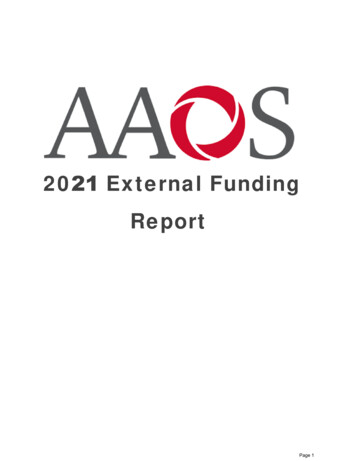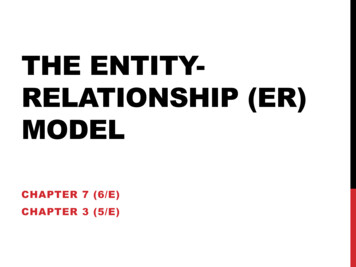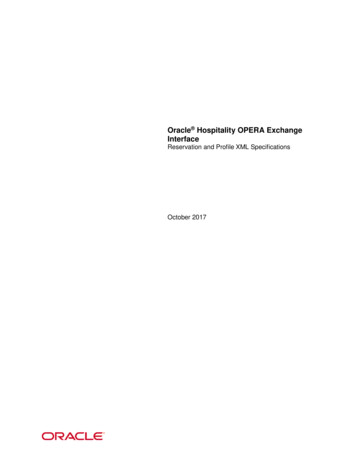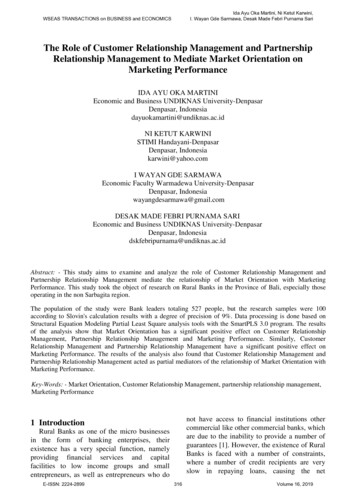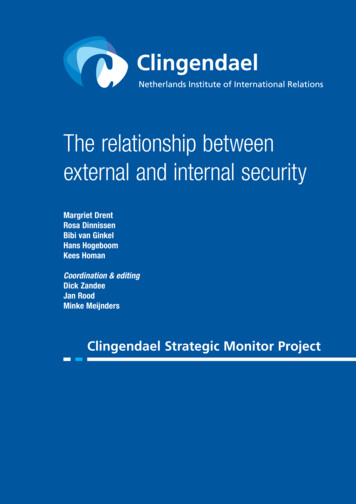
Transcription
The relationship betweenexternal and internal securityMargriet DrentRosa DinnissenBibi van GinkelHans HogeboomKees HomanCoordination & editingDick ZandeeJan RoodMinke MeijndersClingendael Strategic Monitor Project
The relationship between external and internal securityMargriet Drent (immigration)Rosa Dinnissen (immigration)Bibi van Ginkel (terrorism)Hans Hogeboom (crime)Kees Homan (cybercrime)Coordination & editingDick ZandeeJan RoodMinke MeijndersClingendael Strategic Monitor ProjectPublication: June 2014Translation: January 2015
ColophonTranslation: Business Translation Services B.V.This study, ‘The relationship between external and internal security’, has already been published in Dutch as part of the larger Clingendael Strategic Monitor 2014 (Een wankelewereld orde: Clingendael Strategische Monitor 2014, edited by Jan Rood) in the context ofthe Clingendael Strategic Monitor Project. A Clingendael Monitor is published yearly and is commissioned by the Dutch government.January 2015 Netherlands Institute of International Relations Clingendael.All rights reserved. No part of this book may be reproduced, stored in a retrieval system,or transmitted, in any form or by any means, electronic, mechanical, photocopying, recording,or otherwise, without the prior written permission of the copyright holders.About the authors, coordinators & editorsRosa Dinnissen was project- and research assistant at the Clingendael Institute during thisresearch. In January 2015 she started as a Training and Research Fellow at the ClingendaelAcademy.Margriet Drent is a Senior Research Fellow at the Clingendael Institute. She specialises insecurity and defence with a specific focus on EU Common Security and Defence Policy.Bibi van Ginkel is Senior Research Fellow at the Clingendael Institute. She is also a fellow atthe International Centre for Counter-Terrorism (ICCT) in The Hague. She focuses her researchon the legal aspects of the fight against terrorism in national and international context.Luc van de Goor is Director Research at the Clingendael Institute. In his research he focuseson conflict prevention and early warning, Security Sector Reform, Demobilisation, Disarmament and Reintegration, peacebuilding, and whole of government approaches.Hans Hogeboom was on secondment from the Dutch National Police during this research.He focuses on futures studies in the area of security and police, robotics and cross-bordercriminality.Kees Homan is Senior Research Associate at the Clingendael Institute and former directorof the Dutch Defence College. He focuses his research on international security issues andstrategic and military issues, including the security and defence policy of the EU, the US, andChina.Minke Meijnders is project- and research assistant at the Clingendael Insititute. She dealsspecifically with international security related issues, such as maritime security, terrorism andpeacekeeping operations.Jan Rood is a Senior Research Fellow at the Clingendael Institute, where he covers globalissues and European integration. He is Professor of European Integration in a Global Perspective at Leiden University.Dick Zandee is Senior Research Fellow at the Clingendael Institute. His research focuses onsecurity and defence issues, including policies, defence capability development, research andtechnology, armaments cooperation and defence industrial aspects.Clingendael InstituteP.O. Box 930802509 AB The HagueThe NetherlandsEmail: info@clingendael.nlWebsite: http://www.clingendael.nl/
ContentsIntroduction 51Current situation 7General 7Immigration 13Terrorism 23Cross-border crime 31Cybercrime 39Conclusion 472Future risks and threats 48Immigration 48Terrorism 49Cross-border crime 51Cyber issues 52Conclusion 533Conclusions and points to note for the Netherlands 56General 56Immigration 58Terrorism 59Cross-border crime 60Cyber issues 61Other 624
IntroductionThe interrelatedness of external and internal security is not a new phenomenon. A relationship between conflicts such as those that occurred in the Balkans and internal security,a relationship that manifested itself in the form of, for example, illegal immigration andan increase in cross-border crime, was also clearly visible in the 1990s. Nevertheless, the9/11 attacks in the United States in 2001 and the attacks on civilian targets in Europe, particularly the 2004 Madrid train bombings and the 7/7 London bombings of 2005, truly broughtforeign-bred terrorist violence into the domestic sphere. The shock caused by these attacksmade the relationship between external and internal security that much more tangible andmade everyone more aware that external and internal security were part of single wholerather than separate dimensions. This is certainly true with respect to terrorism. The spillovereffects of instability and conflicts elsewhere in the world are also increasingly affecting European nations, however. There is a direct link, for example, between human trafficking, drugtrafficking and other forms of organised crime and volatile countries and regions, particularlyin the Middle East and Africa.National security strategies, the organisation of national security and the structures in placeto maintain it, as well as the capabilities required in this regard, also in terms of civil-militarycooperation, have therefore come to be seen in a different light.The relationship between external and internal security is also being increasingly recognisedat the European level. Relevant actors in the European Union (EU) have started cooperating ina range of activities that, based on the idea of dealing with an issue at its source, include military and civilian operations carried out in the context of the Common Security and DefencePolicy (CSDP) in places like Kosovo and in certain parts of Africa. In addition, military assetsare being used to an increasing extent to guard Europe’s external borders.The examples of practical cooperation between different actors in the field of external andinternal security cannot conceal the fact, however, that there is tension or even an unwillingness to optimally support each other at times. Moreover, there are legal and organisationalobstacles in the EU because of the separation of intergovernmental foreign policy/defencepowers and the largely Community responsibilities for internal security.Questions concerning the effects that developments in the relationship between external andinternal security will have on the Netherlands must be considered against this background.What, for example, does the intertwined nature of external and internal security mean forDutch security policy? What are the most relevant risks and threats? How will these risks andthreats develop in the future? What are the potential consequences for policy instrumentsand what capabilities are required in civilian and military terms and in terms of the coordination of these capabilities? What effect is the steadily increasing Europeanisation of internalsecurity having on these national policy components? What developments can be seen in theNetherlands’ key partner countries (Belgium, Germany, France and the United Kingdom)?Chapter 1 of the study deals with the current situation and developments in terms of risks andthreats, national and international policy, organisation and capabilities. Chapter 2 addressesfuture risks and threats for a period of five to ten years. Chapter 3 sets out conclusions and alist of points to note for policymakers in the Netherlands.5
The relationship between external and internal security Clingendael Strategic Monitor Project, Publication: June 2014Chapters 1 and 2 are divided into general sections and sections about four specific policyareas in which external and internal security overlap, namely immigration, terrorism,cross-border crime and cybercrime. Developments regarding disasters, which can also havea major impact on security, are considered in a separate box at the end of this study.In 2010, EU member states defined the four policy areas referred to plus disasters as encompassing common challenges in the context of internal security. There can at times be linksbetween immigration, terrorism, cross-border crime and cybercrime. These links are specifiedto the greatest extent possible in the study. In addition, specific attention is devoted to fourpartner countries (Belgium, Germany, France and the United Kingdom) in order to make comparisons with the situation in the Netherlands.This study focuses on the interaction between external and internal actors in terms of policy,organisation and capabilities for deployment on national territory. Consequences for deployment in crisis management operations are discussed in a separate study on the future ofpeacekeeping operations.This research is based on a study of the literature and data files. Figures are presented intables and graphs to the greatest extent possible. To supplement the literature, professionalswho deal with external and internal security issues on a daily basis in the four partner countries at national level or at international organisations were interviewed for the analysis offuture risks and threats.In April of this year, members of the Islamic terrorist group Boko Haram kidnapped over 200 schoolgirls in Nigeria.Fighting between his group and Nigerian government forces had already claimed over 1,500 lives in the first monthsof 2014. In May, the UN Security Council blacklisted the terrorist movement.Photograph: Michael Fleshman6
1Current situationGeneralCurrent risks and threatsSecurity has many dimensions. In terms of internal security, terrorist threats or major crimemay pose a life-threatening danger. Other risks can likewise threaten the functioning ofsociety or parts of a society. Cyber attacks are a prime example in this regard. In a similarvein, immigration can cause problems if there is a lack of social integration, just as an interruption in the supply of energy or raw materials can disrupt an economy and undermine thewell-being of the population. Environmental pollution can adversely affect health, and epidemics and diseases can become global challenges. In short, external developments affectour internal security.The 9/11 attacks in the United States in 2001 and attacks in Europe, particularly the 2004Madrid train bombings and the 7/7 London bombings of 2005, made the consequences ofnon-traditional military threats to internal security very tangible. Internal security became ahigher priority on the political agenda in the EU as a whole and in individual member states.An EU Internal Security Strategy was adopted by member states in 2010. The action plan forimplementation of this strategy defines five areas as ‘common threats’ that are increasing inscale and scope, namely international criminal networks, terrorism, cybercrime, border security and disasters.1A 2011 Eurobarometer study surveyed the security perceptions of people living in the EU(see Table 1).2 The threats of terrorism, organised crime and illegal immigration came high onthe list. Cybercrime was viewed as a threat that would rapidly become more acute.3The European population did not consider wars as a major threat. This development is ofcourse closely linked to the changed security situation. The threat of large-scale violence andarmed conflict in Europe of the kind that took place in the Balkans in the 1990s has becomeless prominent. Greater stability and prolonged peace on the European continent haveperhaps also reduced the willingness to deploy armed forces in operations far from home.Just under 60% of the Dutch population thinks that the Ministry of Defence should focusmore on national duties, while less than half of the population considers it important to contribute to international missions.4 This domestic orientation regarding security threats couldexplain why there is less support for Dutch participation in crisis management operationsoutside Europe.1234European Commission, Communication from the Commission to the European Parliament and the Council – TheEU Internal Security Strategy in Action: Five steps towards a more secure Europe, COM (2010) 673 final. Brussels:22 November 2010.Idem.Although the percentages had dropped in 2013 for terrorism (to 2%), crime (11%) and immigration (12%), thequestion did not specifically relate to security threats in the 2013 Eurobarometer. See European Commission,Public Opinion in the European Union – First Results, Standard Eurobarometer 80, November 2013.Tim de Beer and Désirée Oldenhuis, Defensie in strategisch opzicht, TNS NIPO report. Amsterdam: June 2013.7
The relationship between external and internal security Clingendael Strategic Monitor Project, Publication: June 2014Table 1Most important threats to security in the EU5Economic and financial crises34%Terrorism33%Organised crime21%Poverty18%Illegal immigration16%Corruption15%Environmental issues / climate change12%Natural disasters11%Nuclear disasters10%Instability of European borders10%CybercrimeWarsReligious extremismMinor crimeOtherEU27Don’t know9%7%6%5%6%11%Current national policy, organisation and capabilitiesAlthough the Dutch government recognises the close relationship between external andinternal security, the Netherlands does not have an integrated security strategy. In addition toa National Security Strategy (2007, with later amendments), an International Security Strategywas unveiled in 2013. The latter sets out guidelines for Dutch action with respect to conflictsand instability elsewhere in the world, with an emphasis on the 3D approach of Diplomacy,Defence and Development, while the former focuses mainly on strengthening domestic security. The National Risk Assessment classifies security risks according to a grid defined byprobability and effect axes (see Figure 1).In organisational terms, there is no overarching structure in the Netherlands. The coordination of foreign and domestic aspects of the security policy tales place between the variousministries involved. Coordinating bodies are usually placed under a line ministry or theMinistry of General Affairs. There is no national security council. The Netherlands has hada ministerial crisis management committee since 2013, however. Unless the prime ministerdecides to chair the committee, it operates under the direction of the Ministry of Securityand Justice. The purpose of this committee is to increase clout and unequivocalness in crisis decision-making at national level. There is an interdepartmental coordinating structure underthe committee. This structure includes a network of operational centres that coordinate theavailability and use of capabilities that are within the competence of the different ministries.5European Commission, Internal Security Report, Special Eurobarometer 371, November 2011.8
CatastrophicThe relationship between external and internal security Clingendael Strategic Monitor Project, Publication: June 2014Worst possible floodDyke ring 14 area (South Holland) floodDeliberate, prolongedpower supply failureArms control ina failing stateVery seriousCriminal interference inMass polarisationvital businessCyber espionageConfrontation with membersDisruptionoftheIP-network(ICT) Effect on public administrationof ethnic sel flood -members of the extreme rightScarcity of mineralsMajor unrestNuclear incidentCyber conflictDeliberate power supply disruptionUnrest in problem districtsBlizzardAnimal rights extremistsIslamic extremismFailure of satellite systems Glazed frostCrisis outside the EUReaction to exogenousNational power blackoutjihadist threatDeliberate gas supply disruptionChemical incidentCyber hacktivismUnrest about SalafismDeliberate gas supplyHeavy stormdisruptionWildfiresFood scarcity-soya beansAnimal rights activismConsiderableSeriousShipping industry accidentTrain accidentLimitedLone wolfRight-wing extremismHeat-droughtMild flu pandemicLeft-wing extremismEffect on stock marketFailure of internet exchangeHighly unlikelyFigure 1UnlikelySomewhat likelyLikelyHighly likelyPositions of scenarios in the risk diagram6The Dutch armed forces have supported the authorities that are responsible for nationalsecurity for many years, both ad hoc and on a structural basis. The Royal NetherlandsMarechaussee provides support on a structural basis under the Police Act 1993.7 Supportingcivilian authorities has even been a third main duty of the armed forces since 2000. Supportprovided on an ad hoc basis is regulated within the framework of the Intensification of Civil-Military Cooperation project and concerns all branches of the armed forces.8 In practice, the Royal Netherlands Army makes the largest contribution in this context. A third ofmilitary personnel are permanently in a state of readiness to assist the civilian authoritiesthat are responsible for security. In addition, actual deployment of the armed forces for theperformance of national duties increased substantially in recent years. The number of adhoc requests for military support rose from 23 in 2008 to 162 in 2012. The Strengthening Civil-Military Cooperation working group commenced its activities at the end of 2012.Although this working group originally consisted of official representatives of the Ministry ofDefence and Ministry of Security and Justice, it was later enlarged to include representativesof other ministries, the Security Board (this board consists of the chairpersons of the 25 security regions), the Netherlands Institute for Safety, Brandweer Nederland (the network organisation for fire services in the Netherlands) and other stakeholders involved in crisis management and disaster response. The working group identifies additional capabilities that thearmed forces can provide and considers how new insights and knowledge and experiencegained can be used. Work performed in the context of the Intensification of Civil-Military678National Institute for Public Health and the Environment (RIVM), De Nationale Risicobeoordeling Rapport2012, November 2013, p. 12. Available at ies/ 012.html.The Police Act 2012 entered into force on 1 January 2013.The capabilities that the Ministry of Defence must guarantee in terms of availability are set out in theBestuursafspraken inzake intensivering civiel-militaire samenwerking (administrative agreements on the intensification of civil-military cooperation) of 2007.9
The relationship between external and internal security Clingendael Strategic Monitor Project, Publication: June 2014Cooperation project focuses primarily on deployment during the ‘warm phase’, whereas theStrengthening Civil-Military Cooperation working group focuses mainly on strengtheningcooperation during the ‘cold phase’. Activities include sharing knowledge, taking part in jointeducational programmes, training and exercises, exploring new areas of cooperation, simplifying procedures and providing support for command and control and the provision of otherinformation for deployment options.9The Netherlands Coastguard is exceptional in nature. Although the organisation is undercivilian authorities, the Coastguard Centre, which is located at the naval base in Den Helder,its integrated staff includes military and civilian personnel. Assets like aircraft and helicoptersoperate under the responsibility of different ministries and pilots are often military personnelon active service.Situation in neighbouring countriesThe countries neighbouring the Netherlands have different policies, organisational structuresand capabilities.BelgiumBelgium does not have a national security strategy. The abolition of the Gendarmerie, a paramilitary police force, in 2001 limited the role of the armed forces in terms of the supportprovided to the Ministry of Justice and Ministry of the Interior. Nevertheless, providing military expertise or capabilities to ensure the security of Belgian society is one of the dutiesof the armed forces.10 Disposing of explosive ordnance from the First World War is a recurring activity. On average, the Service for the Clearance and Destruction of Explosives (DOVO)receives 3,000 requests a year. The service therefore deals with 200 to 300 tonnes of explosives each year.11 On special request, the Belgian armed forces support the Belgian policeon an ad hoc basis in search operations or in securing locations. The armed forces can alsobe deployed to provide civilian services in the event of disasters and other emergencies.There is no structural connection with the civilian authorities in the form of the Intensification of Civil-Military Cooperation project in the Netherlands. The navy is part of the Belgiancoastguard, however. In the context of disaster response and relief, the Belgian governmentcan deploy Belgian First Aid and Support Teams (B-FASTs), units that consist of civilian and military experts.GermanyGermany also does not have a national security strategy, yet the federal government emphasises the importance of the whole-of-government approach with respect to security. Thisapproach is known as Vernetzte Sicherheit, though this term is often used to refer to external action and is comparable to the 3D approach or the comprehensive approach. The Bundeswehr, the unified armed forces of Germany, is available on call to go into action inthe event of threats to national security or in the event of disasters (in practice usually inthe event of a flood). The division of powers between the federal level (Bund) and the states(Länder), including in terms of police forces, means specific coordination problems. Thestates are responsible for police duties in territorial waters, for example, while the federal9Col J.P.L. (Jean-Paul) Duckers, M.S. (Marcel) van Eck, LLM, ‘Versterking Civiel-Militaire Samenwerking’ inMagazine Nationale veiligheid en crisisbeheersing, 12 (2014) 1.10 Belgian Defence Staff, Opdrachtverklaring van Defensie en Strategisch kader voor paraatstelling, 1 October 2011.11 Frigate Captain, Passed Staff College, Renaud Flamant (ed.), De waarde van de Belgische Defensie. Brussels:January 2014, p. 31.10
The relationship between external and internal security Clingendael Strategic Monitor Project, Publication: June 2014police force is responsible for the exclusive economic zone. Regarding maritime security, civilian and military actors remain separated. The German navy only has a liaison officer inthe Maritimes Sicherheitszentrum, the Maritime Safety and Security Centre.12FranceIn France, the national security strategy is set out in the White Paper on Defence and NationalSecurity. The most recent edition was released in 2013.13 It devotes considerable attentionto modern threats to national territory. The whole-of-government approach is emphasised,in the context of which the Ministry of Defence plays a leading role. Under the ultimateresponsibility of the prime minister, the Secretary-General of Defence and National Securityis responsible for cooperation between all of the civilian and military authorities. Around10,000 military personnel are permanently available for national security duties. The Frenchcoastguard consists of military personnel and, as the Gendarmerie Maritime, forms part of thenational Gendarmerie.United KingdomThe United Kingdom strongly emphasises the whole-of-government approach, which isa core element of its 2010 National Security Strategy.14 An overarching National SecurityCouncil headed by the prime minister oversees implementation. All ministries and agencies involved in domestic and foreign security matters are represented in the council. Frictionand bureaucratic conflicts about powers occur below this highest policy level, however.15The UK coastguard is a conglomerate of actors that, although not integrated, coordinate theiractivities. Shortages on the one hand, and a duplication of resources on the other, remainan issue.16International developmentsBoth the EU and NATO recognise the increasing interrelatedness of external and internal security. The organisations differ in terms of powers, however. Whereas the EU has far-reaching responsibilities regarding internal security, NATO’s responsibilities are purelymilitary in nature (territorial defence). Cooperation with civilian authorities takes place primarily in the context of NATO crisis management operations. Internal security agenciescooperate mainly by exchanging information and knowledge.17The European Security Strategy (ESS), which was adopted in 2003 and amended in 2008,notes that external and internal aspects of security are indissolubly linked.18 Nevertheless,the EU has separate strategies for external action (ESS) and internal security. The EU’s 201012 For more details see Margriet Drent, Kees Homan and Dick Zandee, Civil-Military Capacities for EuropeanSecurity, Clingendael Report. The Hague: Clingendael Netherlands Institute of International Relations,December 2013.13 French Ministry of Defence, Livre Blanc – Défense et Sécurité Nationale 2013. Paris: 2013.14 UK HM Government, A Strong Britain in an Age of Austerity: The National Security Strategy. London:October 2010.15 Although it sees improvements, the UK Parliament remains critical about the lack of proper coordinationbetween ministries in the implementation of the whole-of-government approach. See Joint Committee ofthe National Security Strategy, The Work of the Joint Committee on the National Security Strategy in 2012,Second Report of Session 2012-2013, HL Paper 115 HC 984. London: 11 February 2013.16 House of Commons Defence Committee, Future Maritime Surveillance, Fifth Report of Session 2012-2013,HC 110. London: 19 September 2012.17 NATO’s International Secretariat has an Emerging Security Challenges Division for this purpose.18 A Secure Europe in a Better World: European Security Strategy. Brussels: 12 December 2003.11
The relationship between external and internal security Clingendael Strategic Monitor Project, Publication: June 2014Internal Security Strategy focuses mainly on improving coordination between the civilianactors that are responsible for the various areas of internal security. It does not really focuson the authorities that are in charge of external action. Coordination with the EU’s CommonSecurity and Defence Policy sector remains limited mainly to joint meetings of the tworesponsible committees.19 There is no structural cooperation between the European agencies that implement policy and plan and direct activities. There is therefore a gap betweenthe EU actors that are active in the fields of external and internal security, partly becauseof the legal separation of powers between the intergovernmental Common Security andDefence Policy and the largely communitarian internal security policy. Bureaucratic andcultural factors reinforce the separate worlds. The external security policy is dominated bydiplomacy and military working methods, whereas the internal security policy is dominatedby an approach based on law enforcement by the police and the administration of justice bycourts. In addition, some member states are concerned about a potential ‘militarisation’ ofinternal security, also at EU level, while military personnel are sometimes excessively inclinedto impose their working methods on civilian actors.In practice, there is ad hoc cooperation in Common Security and Defence Policy operations.This cooperation is principally aimed at dealing with threats posed by extremist, criminal andterrorist groups. Military assets are likewise used on an ad hoc basis for EU agencies thatoperate in the field of internal security like Frontex, the agency that manages operationalcooperation at the EU’s external borders. Practical arrangements appear to be the best optionat the present time, since there is currently no political willingness to radically amend thetreaty. During its December 2013 meeting, the European Council stressed the importance ofthe relationship between external and internal security and called for an EU Maritime SecurityStrategy and an EU Cyber Defence Policy Framework. The council also took steps towards thedevelopment of dual-use capabilities like unmanned aerial vehicles for reconnaissance missions. These trends, an approach for each sector and a practical focus, look set to continue inthe near future. They build on the pragmatic approach originally established by the EuropeanDefence Agency, an approach aimed at creating synergy between military and civilian usersthrough civil-military coordination based on the particular set of needs. This approach servestwo purposes: it fosters civil-military standardisation and interoperability while at the sametime cutting costs by increasing scale. For the same reason, the approach can help to preventduplication of investments.The specific areas of internal security – that is, the common challenges defined in the EU’sInternal Security Strategy – are discussed in greater depth below. These areas are immigration, terrorism, cross-border crime and cybercrime. An overview of current risks and threatsis first given for each of these four areas. Statistics, graphs and maps have been includedto provide further clarification. The specific security area is then discussed in terms ofcurrent national policy, organisational structures and the capabilities available, after whichthe situation in each of the Netherlands’ four partner countries, namely Belgium, Germany,France and the United Kingdom, is outlined. Finally, developments in the relevant international organisations are discussed. The emphasis in this context is on the EU because of thisorganisation’s increasing responsibilities with respect to internal security, partly in relation toits external action. The challenges of disasters, whether natural or man-made, constitute aspecial category. Although disasters
Kees Homan is Senior Research Associate at the Clingendael Institute and former director of the Dutch Defence College. He focuses his research on international security issues and strategic and military issues, including the security and defence policy of the EU, the US, and China.



